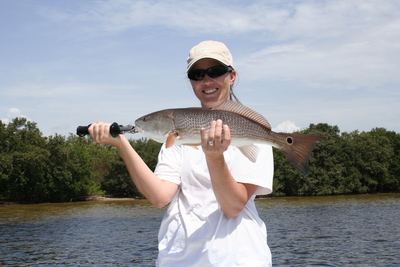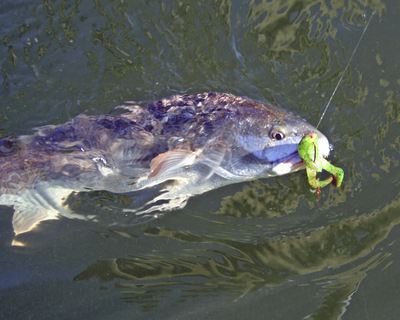Once in danger of commercial overharvesting, redfish are now protected and classified as a gamefish. Having a slot limit of not less than 18" or more than 27", with no closed season, and a one fish per person per day restriction; redfish are known for their aggressive strikes and tremendous power.
They are indisputably one of the top recreational gamefish. Usually spawning from August to November in offshore waters the young migrate into bays and estuaries where they survive for several years. Although migratory in nature reds are basically territorial and tend to remain with a respectable food source. On the other hand, when fishing pressure becomes too great, you can expect them to travel. Opportunistic feeder's they like a myriad of foods similar to crabs, fish, and shrimp either alive or dead. And while they typically feed on bottom dwelling species, redfish will also chase down and aggressively attack artificial lures. Although they can tolerate higher temperatures feeding redfish are usually more comfortable in water temperatures averaging between 70 and 80 degrees. However if water temperatures drop below 60 they usually desert the flats heading for nearby creeks, rivers, and channels.
Tackle -
Not Too Heavy: The average inshore redfish angler is confronted with a wide array of options when choosing tackle. Unless you're targeting extremely big fish never go too heavy. In all probability the majority of your inshore fishing involves flats, mangroves, docks and oysters. Therefore, consider a 6 to 7 foot medium to medium heavy spinning rod and reel. Spool it with 10 to 15 pound braid, 15 to 20 inches of Seaguar Fluorocarbon leader, a 1/0 or 2/0 Daiichi circle hook using a loop knot, and you're ready for serious inshore redfish action. In an equivalent approach, fly anglers can use an 8 or 9 weight outfit with relevant tippets. Baits (Live-Dead-Artificial): The next time, you're cleaning a redfish examine its stomach contents. You'll primarily find a variety of crustaceans unless you're chumming with greenbacks. Experienced anglers recognize that reds have a ravenous desire for food and as a rule take a variety of offerings. These include small baitfish, shrimp, crabs, or dead cut-baits and some of the favorites are cut ladyfish, pinfish and mullet.
They're also not shy about taking artificial lures. Some top artificial's are plastic jerkbaits on a jighead, Bucktails, gold and silver spoons, and even hard baits like MirrOlure's Top Dog, High Roller's Rip Roller and a new lure called Thunder Shad's Model 601. While any artificial lure represents a potential meal you must have confidence it will catch fish and it must be presented correctly.
Like most saltwater species, moving water has a strong influence on feeding times. Incoming tides definitely control feeding times as it moves onto a flat or into the mangroves. Conversely, fishing an incoming tide has its disadvantages unless you have a shallow draft boat or poling skiff. In saying this, remember wading is always an option and an excellent way to catch redfish.
Redfish are notorious for their outstanding sense of sight, movement and sound especially when feeding shallow. Above all other times, shallow water makes them incredibly aware of their surroundings and what's going on above and below the surface. Also because of their acute eyesight they can quickly detect an angler's movements and shadow. Stealth and a low profile is a must when hunting reds.
Secrets to Victory:
Resembling fishing in general, when targeting reds you've got to be in the right place, at the right time, and with the right bait and tackle. So, where do we begin looking for redfish? Here are a few excellent places to target these mighty inshore tackle busters.
Grass/Mud Flats:
When looking for redfish one of the best places to target is the many shallow grass or mud flats found around inter-coastal estuaries and bays. As mentioned earlier, redfish are opportunistic feeders often joining with schools of mullet, jacks, and stingrays. As these fish feed they stir up the bottom and create what's often referred to as mud or muddy water. If you're fishing a flat when schooling reds move in; your trip can quickly turn from fishing to catching.
Oyster/Shell Beds:
Oyster or shell bars are great places, especially those with good tidal flows.
As the current travels across and around these bars it creates a deeper swash or wash. Fish tend congregate on the down current side as it brings food. Live, dead and artificial lures usually produce in these areas. Mangrove Shorelines: Mangroves on high tides always embrace fish as they move into the root systems to feed. The trick is getting a bait or lure back far enough to invite a strike. Tip: Dead sticking cut and stinky baits along the edges especially as the tide continues to flood usually rings the dinner bell bringing them out to investigate. Docks/Structure: One of my favorites is docks and structure simply, because they naturally hold bait. I normally use artificial lures skipping them under and around the dock or structure. The older and less traveled the better when it comes to finding redfish. If you've never gone after a redfish, do yourself a favor and go. It's an experience you'll never forget.
For more information or to get out and catch a few. Contact Capt. Woody Gore and "Let's Go Fishing". You can reach me on my cell at: 813-477-3814. Email wgore@ix.netcom.com or visit my informative website: www.captainwoodygore.com.
This article is owned by Capt. Woody Gore (wgore@ix.netcom.com) and is copyright protected. Permission to republish this article in print or online must be granted by Capt. Gore.




